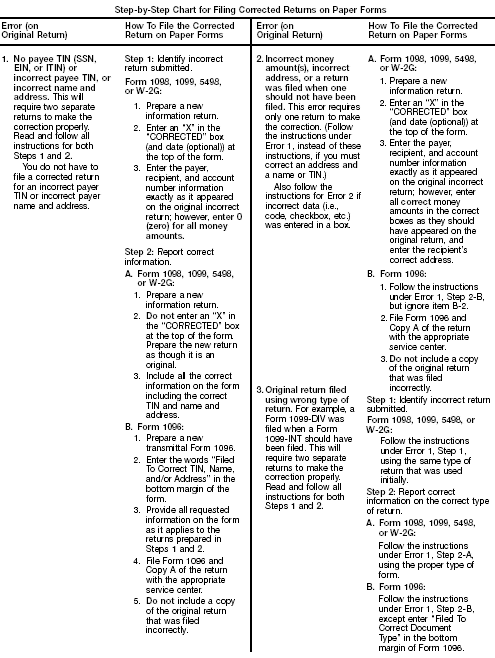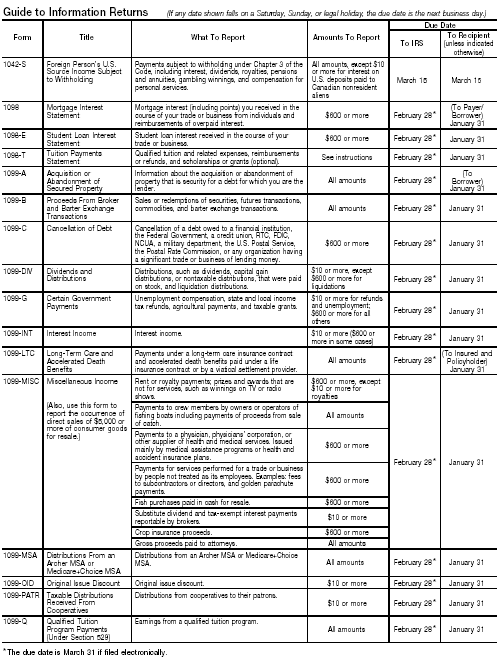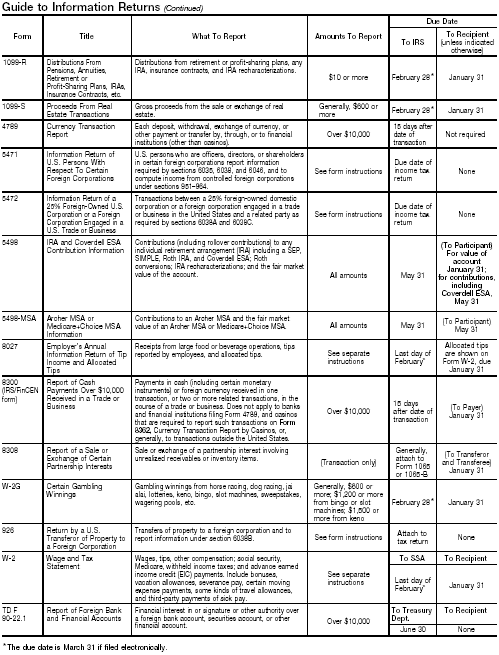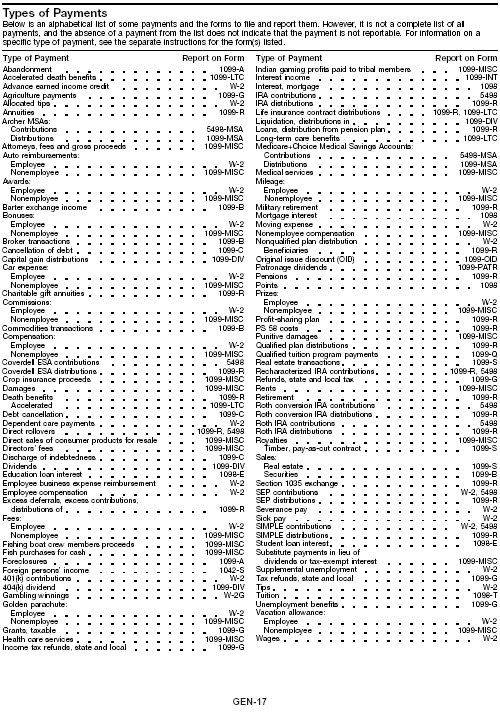I. Corrected Returns
If you filed a return with the IRS and later discover you made an error on it, you must correct it as soon as possible. For some corrections, you
must file two returns (Form 1099, 1098, 5498, or W-2G) with Form 1096 and for some only one return with Form 1096.
In addition, you must provide statements to recipients showing the corrections as soon as possible.
 If you fail to file correct information returns or furnish a correct payee statement, you may be subject to a penalty. See Penalties on
page GEN-4.
If you fail to file correct information returns or furnish a correct payee statement, you may be subject to a penalty. See Penalties on
page GEN-4.
To determine whether you are required to submit corrections on magnetic media, see Magnetic Media/Electronic Reporting on page GEN-4 and
Pub. 1220.
When making a correction, be sure you complete all appropriate information on the returns. Then file Copy A of the form and Form 1096 with your
Internal Revenue Service Center. Do not cut or separate the forms that are two or three to a page. Submit the entire page even if only one of the
forms on the page is completed. Do not staple the forms to Form 1096. You must use a separate Form 1096 for each type of return you are correcting,
but you may use one Form 1096 for both originals and corrections of the same type of return.
On all Forms 1098, 1099, and 5498, a box is provided for the account number. See Account Number Box on Forms on page GEN-14. If the
account number was provided on the original return, the same account number must appear on both the original and corrected return to
properly identify and process the correction. If you did not provide the account number on the original return, do not include it on the corrected
return.

Step-by-Step Instructions for Filing Corrected Returns on Paper Forms
CORRECTED box.
Each Form 1099, 1098, 5498, and W-2G contains a CORRECTED box at the top of the form. Enter an X in the CORRECTED box on Copy
A only when you are correcting a form you previously submitted to the IRS. Enter an X in the CORRECTED box on the copies you give to the
recipient (Copy B and, in some cases, Copy C) only when you are correcting a form previously furnished to the recipient. When the type of error
requires two returns to make the correction, you will mark the CORRECTED box only on one of the returns. Refer to the Step-by-Step Chart
for Filing Corrected Returns on Paper Forms on page GEN-12 to determine when you should mark the CORRECTED box.
 On a recipient's statement, you may enter a date next to the CORRECTED box. This will help the recipient in the case of multiple
corrections.
On a recipient's statement, you may enter a date next to the CORRECTED box. This will help the recipient in the case of multiple
corrections.
Chart.
The chart on page GEN-12 gives step-by-step instructions for filing corrected returns for three of the most frequently made errors. Correction of
errors may require the submission of more than one return. Be sure to read each section thoroughly.
 Regulations section 301.6724-1 (relating to information return penalties) does not require you to file corrected returns for missing or incorrect
TINs if you meet the reasonable cause criteria. You are merely required to include the correct TIN on the next original return you are required to
file. However, if you do not meet the reasonable cause criteria, you should file corrected returns by August 1 to be subject to a reduced penalty.
Regulations section 301.6724-1 (relating to information return penalties) does not require you to file corrected returns for missing or incorrect
TINs if you meet the reasonable cause criteria. You are merely required to include the correct TIN on the next original return you are required to
file. However, if you do not meet the reasonable cause criteria, you should file corrected returns by August 1 to be subject to a reduced penalty.
In addition, even if you meet the reasonable cause criteria, the IRS encourages you to file corrections for incorrect or missing TINs so that the
IRS can update the payees' records.
J. Void Returns
An X in the VOID box at the top of the form will not correct a previously filed return. See Corrected Returns above for
instructions for making corrections.
VOID box.
If a completed or partially completed Form 1098, 1099, or 5498 is incorrect and you want to void it before submission to the IRS, enter an X
in the VOID box at the top of the form. For example, if you make an error while typing or printing a form, you should void it. The return will
then be disregarded during processing by the IRS. Go to the next form on the page, or to another page, and enter the correct information; but do
not mark the CORRECTED box. Do not cut or separate the forms that are two or three to a page. Submit the entire page even if only one of
the forms on the page is a good return.
K. Other Information Returns
The income information you report on the following forms must not be repeated on Forms 1099 or W-2G:
- Form W-2 reporting wages and other employee compensation.
- Forms 1042-S and 1000 reporting income.
- Form 2439 reporting undistributed long-term capital gains of a regulated investment company or real estate investment trust.
- Schedule K-1 of Form 1065 or 1065-B reporting distributive shares to members of a partnership.
- Schedule K-1 of Form 1041 reporting distributions to beneficiaries of trusts or estates.
- Schedule K-1 of Form 1120S reporting distributive shares to shareholders of S corporations.
- Schedule K of Form 1120-IC-DISC reporting actual and constructive distributions to shareholders and deferred DISC income.
- Schedule Q of Form 1066 reporting income from a REMIC to a residual interest holder.
L. Payments to Corporations and Partnerships
Generally, payments to corporations are not reportable. However, you must report payments to corporations for the following:
- Medical and health care payments (Form 1099-MISC),
- Withheld Federal income tax or foreign tax,
- Barter exchange transactions (Form 1099-B),
- Substitute payments in lieu of dividends and tax-exempt interest (Form 1099-MISC),
- Interest or original issue discount paid or accrued to a regular interest holder of a REMIC (Form 1099-INT or 1099-OID),
- Acquisitions or abandonments of secured property (Form 1099-A),
- Cancellation of debt (Form 1099-C),
- Payments of attorneys' fees and gross proceeds paid to attorneys (Form 1099-MISC),
- Federal executive agency payments for services (Form 1099-MISC), and
- Fish purchases for cash (Form 1099-MISC).
Reporting generally is required for all payments to partnerships. For example, payments of $600 or more made in the course of your trade
or business to an architectural firm that is a partnership are reportable on Form 1099-MISC. However, see Regulations section 1.6049-4(c)(1)(A).
M. Earnings on any IRA, Coverdell ESA, or Archer MSA
Generally, income earned in any IRA, Coverdell ESA, or Archer MSA, such as interest or dividends, is not reported on Forms 1099. However,
distributions must be reported on Form 1099-R or 1099-MSA.
N. Certain Grantor Trusts
Certain grantor trusts may choose to file Forms 1099 rather than a separate statement attached to Form 1041, U.S. Income Tax Return for
Estates and Trusts. If you have filed Form 1041 for a grantor trust in the past and you want to choose the Form 1099 filing method for 2002, you must
have filed a final Form 1041 for 2001. See Regulations section 1.671-4 and the Instructions for Form 1041 and Schedules A, B, D, G, I,
J, and K-1.
O. Special Rules for Reporting Payments Made Through Foreign Intermediaries and Foreign Flow-Through Entities on Form 1099
If you are the payer and have received a Form W-8IMY, Certificate of Foreign Intermediary, Foreign Flow-Through Entity, or Certain U.S.
Branches for United States Tax Withholding, from a foreign intermediary or flow-through entity, follow the instructions below for completing Form
1099. Definitions of these terms are on page GEN-14.
Presumption Rules
 For additional information including details on the presumption rules, see the Instructions for the Requester of Forms W-8BEN, W-8ECI, W-8EXP,
and W-8IMY and Pub. 515, Withholding of Tax on Nonresident Aliens and Foreign Entities. See How To Get Forms and
Publications on page GEN-3.
For additional information including details on the presumption rules, see the Instructions for the Requester of Forms W-8BEN, W-8ECI, W-8EXP,
and W-8IMY and Pub. 515, Withholding of Tax on Nonresident Aliens and Foreign Entities. See How To Get Forms and
Publications on page GEN-3.
If you are the payer and do not have a Form W-9, appropriate Form W-8, or other valid documentation, or you cannot allocate a payment to a specific
payee, prior to payment, you are required to use certain presumption rules to determine the following:
- The status of the payee as a U.S. or foreign person and
- The classification of the payee as an individual, trust, estate, corporation, or partnership.
See Regulations section 1.1441-1(b)(3), 1.1441-5(d) and (e), 1.6045-1(g)(3)(ii), and 1.6049-5(d).
Under these presumption rules, if you must presume that the payee is a U.S. non-exempt recipient subject to backup withholding, you must report the
payment on a Form 1099. However, if before filing Form 1099 with the IRS the recipient is documented as foreign, then report the payment on a Form
1042-S.
On the other hand, if you must presume that the payee is a foreign recipient and prior to filing Form 1042-S with the IRS you discover that the
payee is a U.S. nonexempt recipient based on documentation, then report all payments made to that payee during the calendar year on a Form 1099.
If you use the 90-day grace period rule to presume a payee is foreign, you must file a Form 1042-S to report all payments subject to withholding
during the grace period. If you later discover that the payee is a U.S. nonexempt recipient subject to backup withholding, you must file a Form 1099
for all payments made to that payee after the discovery of the payee's U.S. status.
Rules for Payments Made to U.S. Nonexempt Recipients Through a QI, NQI, or FTE
If you are the payer making a payment through a QI, NQI, or FTE for a U.S. nonexempt recipient on whose behalf the QI, NQI, or FTE is acting, use
the following rules to complete Form 1099.
Known recipient.
If you know that a payee is a U.S. nonexempt recipient and have the payee's name, address, and TIN (if a TIN has been provided), you must complete
the Form 1099 with that information. Also, on the second name line below the recipient's name enter IMY followed by the name of the QI, NQI, or
FTE.
For payments made to multiple recipients: (1) enter the name of the recipient whose status you relied on to determine the applicable
rate of withholding and (2) on the second name line, enter IMY followed by the name of the QI, NQI, or FTE. However, if the QI has
assumed primary Form 1099 reporting or backup withholding responsibility, you are not required to issue the Form 1099 or to backup withhold. See
Qualified intermediary on page GEN-14.
Unknown recipient.
If you cannot reliably associate a payment with valid documentation and are required to presume a payee is a U.S. nonexempt recipient:
- File a Form 1099 and enter unknown recipient on the first name line.
- On the second name line, enter IMY followed by the name of the QI, NQI, or FTE.
- Enter the EIN of the QI, NQI, or FTE, if applicable, in the recipient's identification number box.
- Furnish a copy of the Form 1099 with unknown recipient to the QI, NQI, or FTE who is acting on the recipient's behalf.
 A payer that is required to report payments made to a U.S. nonexempt recipient account holder but does not receive the necessary allocation
information cannot report those payments on a pro-rata basis. Report unallocated payments using the presumption rules above.
A payer that is required to report payments made to a U.S. nonexempt recipient account holder but does not receive the necessary allocation
information cannot report those payments on a pro-rata basis. Report unallocated payments using the presumption rules above.
Rules for Non-U.S. Payers
Non-U.S. payers (foreign persons that are not U.S. payers) generally have the same reporting obligations as U.S payers. A U.S payer is anyone who
is:
- A U.S. person,
- Any U.S. governmental agency,
- A controlled foreign corporation (CFC),
- A foreign partnership that has one or more U.S. partners who, in the aggregate hold more than 50 percent of the gross income derived from
the conduct of a U.S. trade or business,
- A foreign person who owns 50 percent or more of the gross income that is effectively connected with a U.S. trade or business, or
- A U.S. branch of a foreign bank or a foreign insurance company.
For more information see Regulations section 1.6049-5(c)(5).
Exceptions.
The following payments are not subject to reporting by a non-U.S. payer:
- A foreign source reportable payment paid outside the U.S. For example, see Regulations section 1.6049-5(b)(6).
- Gross proceeds from a sale effected outside the U.S. See Regulations section 1.6045-1(a).
- An NQI or QI that provides another payer all the information sufficient for that payer to complete Form 1099 reporting. For example, see
Regulations section 1.6049-5(b)(14). However, if an NQI or QI does not provide sufficient information for another payer to report a payment on Form
1099, the intermediary must report the payment.
Rules for Reporting Payments Initially Reported on Form 1042-S
If an NQI or QI receives a Form 1042-S made out to an unknown recipient and, the NQI or QI has actual knowledge that the payee of the income
is a U.S. nonexempt recipient, it must file a Form 1099 even if the payment has been subject to withholding by another payer. The NQI or QI reports
the amount withheld by the other payer on Form 1099 as Federal income tax withheld.
Definitions
Foreign intermediary.
A foreign intermediary is any person who is not a U.S. person and acts as a custodian, broker, nominee, or otherwise as an agent for another
person, regardless of whether that other person is the beneficial owner of the amount paid, a flow-through entity, or another intermediary. The
intermediary can be a qualified intermediary or a nonqualified intermediary.
Qualified intermediary (QI).
A qualified intermediary is a person that is a party to a withholding agreement with the IRS and is:
- A foreign financial institution or a foreign clearing organization (other than a U.S. branch or U.S. office of the institution or
organization),
- A foreign branch or office of a U.S. financial institution or a foreign branch or office of a U.S. clearing organization,
- A foreign corporation for purposes of presenting claims of benefits under an income tax treaty on behalf of its shareholders, or
- Any other person the IRS accepts as a qualified intermediary and who enters into a withholding agreement with the IRS.
See Rev. Proc. 2000-12, 2000-4 C.B. 387, for procedures to apply to be a qualified intermediary.
Nonqualified intermediary (NQI).
A nonqualified intermediary is any intermediary that is a not a U.S. person and that is not a qualified intermediary.
Foreign flow-through entity (FTE).
A flow-through entity is a foreign partnership (other than a withholding foreign partnership), a foreign simple trust or foreign grantor trust
(other than a withholding foreign trust), or, for payments for which a reduced rate of withholding is claimed under an income tax treaty, any entity
to the extent the entity is considered to be fiscally transparent under section 894 with respect to the payment by an interest holder's jurisdiction.
Withholding foreign partnership or withholding foreign trust.
A withholding foreign partnership or withholding foreign trust is a foreign partnership or a foreign simple or grantor trust that has entered into
a withholding agreement with the IRS in which it agrees to assume primary withholding responsibility for all payments that are made to it for its
partners, beneficiaries, or owners.
Nonwithholding foreign partnership, simple trust, or grantor trust.
A nonwithholding foreign partnership is any foreign partnership other than a withholding foreign partnership. A nonwithholding foreign simple trust
is any foreign simple trust that is not a withholding foreign trust. A nonwithholding foreign grantor trust is any foreign grantor trust that is not a
withholding foreign trust.
Fiscally transparent entity.
An entity is treated as fiscally transparent with respect to an item of income to the extent that the interest holders in the entity must, on a
current basis, take into account separately their shares of an item of income paid to the entity, whether or not distributed, and must determine the
character of the items of income as if they were realized directly from the sources from which realized by the entity. For example, partnerships,
common trust funds, and simple trusts or grantor trusts are generally considered to be fiscally transparent with respect to items of income received
by them.
P. Account Number Box on Forms
You may use the account number box on all Forms 1099, 1098, 5498, and W-2G for an account number designation. The account number may be
a checking account number, savings account number, serial number, or any other number you assign to the payee that is unique and will distinguish the
specific account. This number must not appear anywhere else on the form, and this box may not be used for any other item. Showing the account number
is optional. However, it may be to your benefit to include the recipient's account number on paper forms if your system of records uses the account
number rather than the name, SSN, or EIN for identification purposes. If you furnish the account number, the IRS will include it in future notices to
you about backup withholding. If you are using window envelopes to mail statements to recipients, and if you are using reduced rate mail, be sure the
account number does not appear in the window because the Postal Service may not accept these for reduced rate mail.
Privacy Act and Paperwork Reduction Act Notice.
We ask for the information on these forms to carry out the Internal Revenue laws of the United States. You are required to give us the information.
We need it to figure and collect the right amount of tax.
Sections 220(h), 408, 408A, 529, 530, 6041, 6041A, 6042, 6043, 6044, 6045, 6047, 6049, 6050A, 6050B, 6050D, 6050E, 6050H, 6050J, 6050N, 6050P,
6050Q, 6050R, 6050S, and their regulations require you to file an information return with the IRS and furnish a statement to recipients. Section 6109
and its regulations require you to show your taxpayer identification number on what you file.
Routine uses of this information include giving it to the Department of Justice for civil and criminal litigation, and to cities, states, and the
District of Columbia for use in administering their tax laws. If you fail to provide this information in a timely manner, you may be subject to
penalties. We may also disclose this information to Federal, state, or local agencies that investigate or respond to acts or threats of terrorism or
participate in intelligence or counterintelligence activities concerning terrorism.
You are not required to provide the information requested on a form that is subject to the Paperwork Reduction Act unless the form displays a valid
OMB control number. Books or records relating to a form or its instructions must be retained as long as their contents may become material in the
administration of any Internal Revenue law. Generally, tax returns and return information are confidential, as required by section 6103.
The time needed to complete and file the following forms will vary depending on individual circumstances. The estimated average times are: 1096, 10
min.; 1098, 7 min.; 1098-E, 3 min.; 1098-T, 9 min.; 1099-A, 10 min.; 1099-B, 15 min.; 1099-C, 10 min.; 1099-DIV, 16 min.; 1099-G, 12 min.; 1099-INT,
12 min.; 1099-LTC, 13 min.; 1099-MISC, 16 min.; 1099-MSA, 8 min.; 1099-OID, 13 min.; 1099-PATR, 15 min.; 1099-Q, 8 min.; 1099-R, 18 min.; 1099-S, 8
min.; 5498, 12 min.; 5498-MSA, 10 min.; W-2G, 19 min.
If you have comments concerning the accuracy of these time estimates or suggestions for making these forms simpler, we would be happy to hear from
you. You can write to the Tax Forms Committee, Western Area Distribution Center, Rancho Cordova, CA 95743-0001. Do not send these forms to
this address. Instead, see Where To File on page GEN-7.

Guide to Information Returns - Page 1

Guide to Information Returns - Page 2

Types of Payments
Previous | First
Instructions Index | 2002 Tax Help Archives | Tax Help Archives | Home
